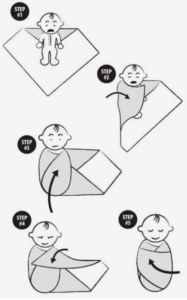As a nurse, I have found these 5 tips the most helpful in calming a crying baby throughout my experience working in the Neonatal Intensive Care Unit. While there are several different strategies, these are my main go-to’s. Whether you are a mother, father, friend, babysitter, or nurse these tips to calming a crying baby are key, as let’s face it – a baby’s cry is not easy!
1. Fulfilling the baby’s needs. Babies usually cry for a reason; whether it’s because they are too hot/too cold, overstimulated or understimulated, hungry, wet, or needing to burp. Getting to know your baby and their cry will help you pinpoint the cues in what they want.
In most cases however, getting to evaluate your baby’s cry is not the best time when they are screaming and you are stressed out. So, trial and error. Have a quick look at your baby; is the pajama visibly soiled, or is your baby sweating, nope? Move on to temperature, is your baby hot/cold? Either unbundle, add a pajama and hat, or close a window causing a draft. Did your baby just eat, but still fussy? Check the diaper in case it is wet or try to burp your little one again. If your baby that just ate their usual amount is still fussy, has a dry diaper and has burped a few times, maybe he’s asking for more! Babies go through several growth spurts in their first couple months. Try putting your baby back to the breast to feed for an extra 10 minutes or give your baby an extra ounce by bottle or as much as the baby seems to want – see if this calms him. Be sure to burp many times throughout the feed to prevent a throwup disaster! If you’ve tried everything above, maybe your baby just wants to be held or needs more help to calm, see below for more suggestions.
2. Bundling and/or holding your baby. Some babies really like to be bundled snuggly. Use a swaddling blanket to bundle your baby, but not too loose so that they can wiggle their ways out of it! Being swaddled tightly or held close to the body reminds babies of their time in the womb; being snug, warm, and comforted.
Does your baby only fall asleep in your arms? You’re not alone! Many babies go through a phase of always wanting to be held. Once they’ve been held a lot after birth they begin to get used to it and sometimes aren’t able to fall asleep in other ways. If you need slight relief around this try putting your newborn in a baby carrier to get things done instead of being tied down.
See below on tips of how to bundle.

3. Bouncing your baby. I want to make this clear, by bounce I do not mean shaking! Bounce your baby gently by placing them in an upright position holding the torso but also supporting the back of the neck and head. Then gently bounce your baby on the bed or on your thighs, allowing for the baby’s feet to touch the surface and knees to bend slightly. Do this and you will hear the sweet sweet sounds of no crying! Getting comfortable handling a newborn in different ways takes some time, but with some practice it will be a breeze!
4. Background noise. If it is too quiet the baby may become fussy because silence is not comforting to them. While babies are in the womb they begin ear development at 9 weeks, begin hearing at 18 weeks, and begin to react to sounds/voices at 25 weeks. They continue to hear sounds throughout the pregnancy; in particular – Mom’s heartbeat. This whooshing heartbeat sound becomes comfortable and normal for a fetus. So, when a baby is crying try to mimic these sounds to provide comfort. Whether it is using a sound machine, music, or making the shh shh sit or whoosh whooshing sounds with your mouth. Try this in combination with bouncing your baby and it will work wonders!
5. Staying calm and carrying on. Babies can sense if their main caregiver is tense and stressed. Not to say that babies are crying because Mom is stressed, but babies can sense the continuous tense behaviours. Being stressed out may also mask what your baby is telling you what they need. Not catching those baby cues and learning your baby’s behaviour can be placed in the back of your mind when you are stressed And the baby is crying non-stop! Just remember that they will stop crying eventually!
Hopefully these 5 tips of calming a crying baby have helped you! This list is certainly not limited, let me know what other methods you use to calm your crying baby.